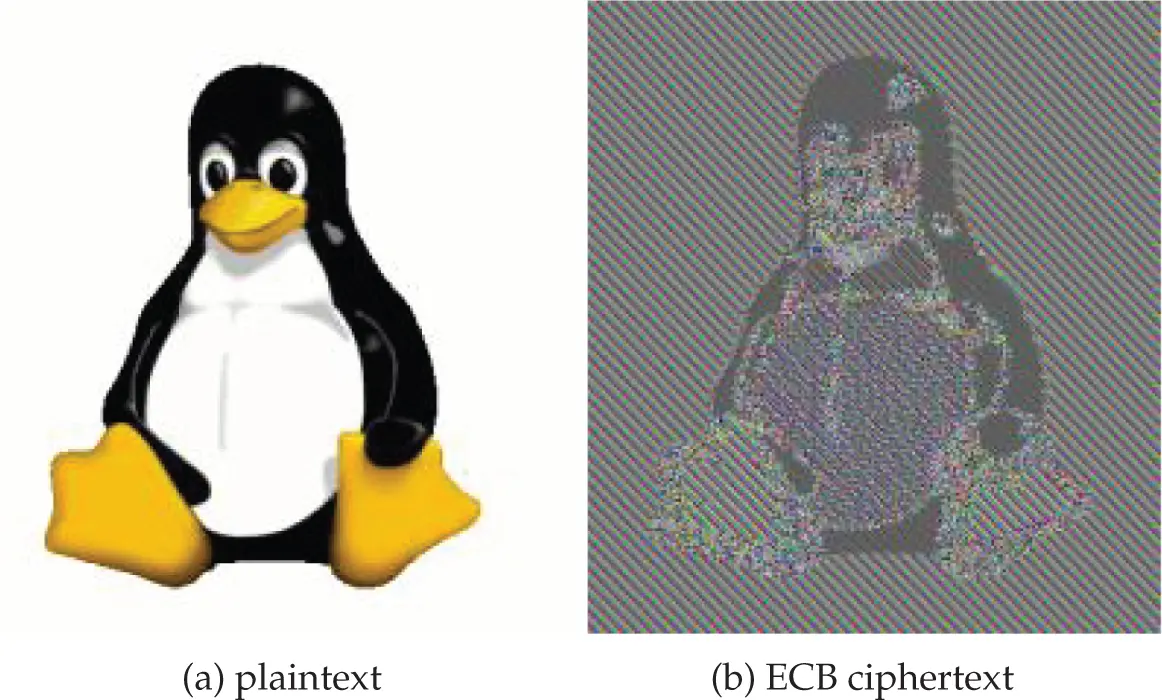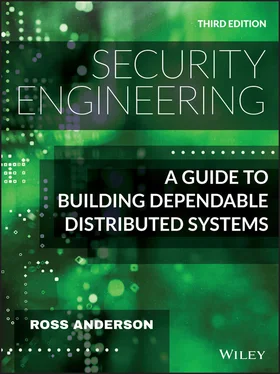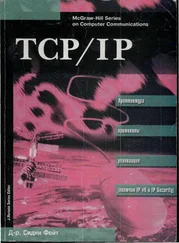Another criticism of DES was that, since IBM kept its design principles secret at the request of the US government, perhaps there was a ‘trapdoor’ which would give them easy access. However, the design principles were published in 1992 after differential cryptanalysis was invented and published [473]. The story was that IBM had discovered these techniques in 1972, and the US National Security Agency (NSA) even earlier. IBM kept the design details secret at the NSA's request. We'll discuss the political aspects of all this in 26.2.7.1.
We now have a fairly thorough analysis of DES. The best known shortcut attack , that is, a cryptanalytic attack involving less computation than keysearch, is a linear attack using  known texts. DES would be secure with more than 20 rounds, but for practical purposes its security is limited by its keylength. I don't know of any real applications where an attacker might get hold of even
known texts. DES would be secure with more than 20 rounds, but for practical purposes its security is limited by its keylength. I don't know of any real applications where an attacker might get hold of even  known texts. So the known shortcut attacks are not an issue. However, its vulnerability to keysearch makes single DES unusable in most applications. As with AES, there are also attacks based on timing analysis and power analysis.
known texts. So the known shortcut attacks are not an issue. However, its vulnerability to keysearch makes single DES unusable in most applications. As with AES, there are also attacks based on timing analysis and power analysis.
The usual way of dealing with the DES key length problem is to use the algorithm multiple times with different keys. Banking networks have largely moved to triple-DES , a standard since 1999 [1399]. Triple-DES does an encryption, then a decryption, and then a further encryption, all with independent keys. Formally:

By setting the three keys equal, you get the same result as a single DES encryption, thus giving a backwards compatibility mode with legacy equipment. (Some banking systems use two-key triple-DES which sets  ; this gives an intermediate step between single and triple DES.) Most new systems use AES as the default choice, but many banking systems are committed to using block ciphers with an eight-byte block, because of the message formats used in the many protocols by which ATMs, point-of-sale terminals and bank networks talk to each other, and because of the use of block ciphers to generate and protect customer PINs (which I discuss in the chapter on Banking and Bookkeeping). Triple DES is a perfectly serviceable block cipher for such purposes for the foreseeable future.
; this gives an intermediate step between single and triple DES.) Most new systems use AES as the default choice, but many banking systems are committed to using block ciphers with an eight-byte block, because of the message formats used in the many protocols by which ATMs, point-of-sale terminals and bank networks talk to each other, and because of the use of block ciphers to generate and protect customer PINs (which I discuss in the chapter on Banking and Bookkeeping). Triple DES is a perfectly serviceable block cipher for such purposes for the foreseeable future.
Another way of preventing keysearch (and making power analysis harder) is whitening . In addition to the 56-bit key, say  , we choose two 64-bit whitening keys
, we choose two 64-bit whitening keys  and
and  , xor'ing the first with the plaintext before encryption and the second with the output of the encryption to get the ciphertext afterwards. This composite cipher is known as DESX. Formally,
, xor'ing the first with the plaintext before encryption and the second with the output of the encryption to get the ciphertext afterwards. This composite cipher is known as DESX. Formally,

It can be shown that, on reasonable assumptions, DESX has the properties you'd expect; it inherits the differential strength of DES but its resistance to keysearch is increased by the amount of the whitening [1049]. Whitened block ciphers are used in some applications, most specifically in the XTS mode of operation which I discuss below. Nowadays, it's usually used with AES, and AESX is defined similarly, with the whitening keys used to make each block encryption operation unique – as we shall see below in section 5.5.7.
A common failure is that cryptographic libraries enable or even encourage developers to use an inappropriate mode of operation . This specifies how a block cipher with a fixed block size (8 bytes for DES, 16 for AES) can be extended to process messages of arbitrary length.
There are several standard modes of operation for using a block cipher on multiple blocks [1406]. It is vital to understand them, so you can choose the right one for the job, especially as some common tools provide a weak one by default. This weak mode is electronic code book (ECB) mode, which we discuss next.
5.5.1 How not to use a block cipher
In electronic code book mode, we just encrypt each succeeding block of plaintext with our block cipher to get ciphertext, as with the Playfair example above. This is adequate for protocols using single blocks such as challenge-response and some key management tasks; it's also used to encrypt PINs in cash machine systems. But if we use it to encrypt redundant data the patterns will show through, giving an opponent information about the plaintext. For example, figure 5.14shows what happens to a cartoon image when encrypted using DES in ECB mode. Repeated blocks of plaintext all encrypt to the same ciphertext, leaving the image quite recognisable.
In one popular corporate email system from the last century, the encryption used was DES ECB with the key derived from an eight-character password. If you looked at a ciphertext generated by this system, you saw that a certain block was far more common than the others – the one corresponding to a plaintext of nulls. This gave one of the simplest attacks ever on a fielded DES encryption system: just encrypt a null block with each password in a dictionary and sort the answers. You can now break at sight any ciphertext whose password was one of those in your dictionary.
In addition, using ECB mode to encrypt messages of more than one block length which require authenticity – such as bank payment messages – is particularly foolish, as it opens you to a cut and splice attack along the block boundaries. For example, if a bank message said “Please pay account number  the sum
the sum  , and their reference number is
, and their reference number is  ” then an attacker might initiate a payment designed so that some of the digits of
” then an attacker might initiate a payment designed so that some of the digits of  are replaced with some of the digits of
are replaced with some of the digits of  .
.

Figure 5.14 : The Linux penguin, in clear and ECB encrypted (from Wikipedia, derived from images created by Larry Ewing).
5.5.2 Cipher block chaining
Читать дальше

 known texts. DES would be secure with more than 20 rounds, but for practical purposes its security is limited by its keylength. I don't know of any real applications where an attacker might get hold of even
known texts. DES would be secure with more than 20 rounds, but for practical purposes its security is limited by its keylength. I don't know of any real applications where an attacker might get hold of even  known texts. So the known shortcut attacks are not an issue. However, its vulnerability to keysearch makes single DES unusable in most applications. As with AES, there are also attacks based on timing analysis and power analysis.
known texts. So the known shortcut attacks are not an issue. However, its vulnerability to keysearch makes single DES unusable in most applications. As with AES, there are also attacks based on timing analysis and power analysis.
 ; this gives an intermediate step between single and triple DES.) Most new systems use AES as the default choice, but many banking systems are committed to using block ciphers with an eight-byte block, because of the message formats used in the many protocols by which ATMs, point-of-sale terminals and bank networks talk to each other, and because of the use of block ciphers to generate and protect customer PINs (which I discuss in the chapter on Banking and Bookkeeping). Triple DES is a perfectly serviceable block cipher for such purposes for the foreseeable future.
; this gives an intermediate step between single and triple DES.) Most new systems use AES as the default choice, but many banking systems are committed to using block ciphers with an eight-byte block, because of the message formats used in the many protocols by which ATMs, point-of-sale terminals and bank networks talk to each other, and because of the use of block ciphers to generate and protect customer PINs (which I discuss in the chapter on Banking and Bookkeeping). Triple DES is a perfectly serviceable block cipher for such purposes for the foreseeable future. , we choose two 64-bit whitening keys
, we choose two 64-bit whitening keys  and
and  , xor'ing the first with the plaintext before encryption and the second with the output of the encryption to get the ciphertext afterwards. This composite cipher is known as DESX. Formally,
, xor'ing the first with the plaintext before encryption and the second with the output of the encryption to get the ciphertext afterwards. This composite cipher is known as DESX. Formally,
 the sum
the sum  , and their reference number is
, and their reference number is  ” then an attacker might initiate a payment designed so that some of the digits of
” then an attacker might initiate a payment designed so that some of the digits of  are replaced with some of the digits of
are replaced with some of the digits of  .
.










